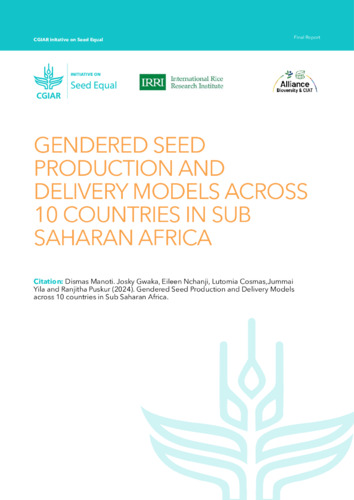Gendered seed production and delivery models across 10 countries in Sub-Saharan Africa
Abstract
The study was conducted in 10 African countries where 166 bean seed production and delivery actors were interviewed. The survey intended to document various production and delivery models used across the regions, the extent to which they involve and benefit women and vulnerable groups, the extent to which they promote availability and access to high-quality seeds, and examine the measures put in place to ensure high-quality seeds reach last mile farmers. The study participants were nongovernmental organizations (NGOs), national agricultural research system (NARS), seed companies and farmer seed producer groups. Purposive sampling was used due to the limited number of bean seed actors along the chain ready to provide information on their activities. Data was collected using the surveyCTO platform and it was managed and analyzed using the Statistical Package for Social Sciences software (SPSS), version 20.
Most actors along the bean seed chain are primarily led by men. The most common production models practiced by the actors are contract farming, seed production cooperatives/groups and seed multiplication and distribution. To a small extent, the actors also utilize a community-based seed production model. The most notable delivery models are direct sales, followed by agrodealer networks and seed fairs and exchanges. The involvement of women and vulnerable groups in both the production and delivery models was found to be satisfactory at a rate of approximately 70%. In addition, the models were found to promote seed availability to men and women when they needed it at the right point and time. Furthermore, the analysis indicates that the models were inclusive increasing access to high quality been seed which was beneficial to women and vulnerable groups. However, the leadership of the seed actors is dominated by male at approximately 69%, which means that a significant number of women have no power to make key decisions along the seed value chain. Been seeds provided by production and delivery models were found to be affordable. However, 19% of the bean seeds provided by the production models were considered to be either expensive or very expensive, whereas 26% of those provided by delivery models were also reported to be expensive or very expensive. This is consistent with the cost of seed, which was 16% and 17% higher for the production and delivery models, respectively.
The main goals of production models are; ensuring availability of high-quality seeds and increasing productivity. While the primary goals of delivery models are; access to high-quality seeds access, profitability/market expansion, increased productivity, inclusivity and the promotion of rural/local economies. Both production and delivery models were reported to be effective at realizing the set goals at 73% and 69% respectively. The most notable programs/policies that have been put in place by delivery models to ensure that farmers afford seeds include flexible payment terms, bulk purchase discounts and credit schemes. In addition, both production and delivery models have enacted measures such as inspections, training, certification, testing, feedback mechanisms and traceability to enhance the quality of seeds as well as helping them in realizing their goals.
In conclusion, the most common production model among the actors is contract farming with the exception of the national agricultural research system (NARS) partners who prefer seed multiplication and distribution models. On the other hand, the commonly adopted delivery model among the actors is direct sales except for the NGO partners who mainly utilize seed multiplication and distribution and agrodealer network. To a large extent, production and delivery models encourage active involvement of men and women in their activities. Additionally, these models are considered beneficial to both genders. However, it should be noted that leadership positions across the actors are dominated by male in contrast with their female counterparts. Furthermore, the models are beneficial and not primarily empowering women and vulnerable groups. This means that, to a great extent, females do not participate in making key decisions along the value chain. The main goal of production models is to make high quality seed available as well as increase productivity. Similarly, delivery models’ primary goal is to provide high quality seeds, increase productivity and make profit. The production and delivery model actors have principally put in place measures such as inspection, certification and training which helps them to effectively achieve their goals. Furthermore, the actors have put in place programs such as subsidies, flexible payment terms and bulk purchase discounts to increase their effectiveness in realizing their goals.
The authors recommends that, to continue realizing the inclusivity of women and vulnerable groups, a multistakeholder
approach geared towards women’s empowerment should be considered for both production and delivery models. Additionally, a key cross-cutting issue is the lack of women in leadership positions so there is a need to establish mechanisms and strategies that will support women’s involvement in leading bean seed entities. Women should be supported to effectively participate in contract farming. It is important to strengthen and expand the agrodealer network since they play an important role in the distribution of seeds.

